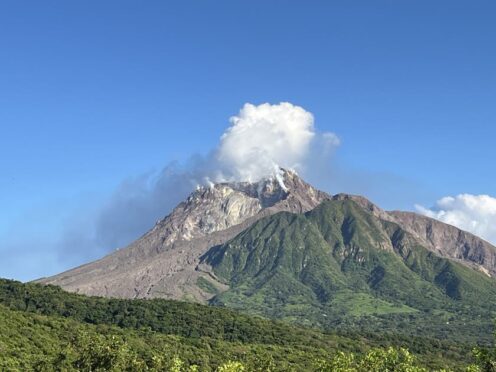
Researchers in the UK are looking to a Caribbean volcano to provide answers about where metals vital for batteries and electric cars can be found, and how power can be generated from its heat.
Volcanoes around the world emit copper, lithium, gold and many other so-called critical metals in their volcanic plumes in similar quantities to those mined every day around the world, experts say.
Fluids called geofluids are found beneath dormant volcanoes, and recovering the minerals dissolved in them, at the same time as generating power, has the potential to make geothermal a viable renewable energy source.
They also have the potential to deliver a significant portion of the critical metals, like lithium which is needed for batteries, necessary for a net-zero energy transition.
Researchers at the Oxford Martin Programme on Rethinking Natural Resources, part of the University of Oxford, are looking at the volcano on the Caribbean island of Montserrat.
They are digging in the ground around the volcano to analyse the geofluids in the hope of creating a blueprint that can be applied to sites across the world.
Professor Jonathan Blundy, from the programme, told the PA news agency: “We are using Montserrat as an example, as a blueprint, and we’ll understand more about what we can do in Montserrat but also what we could do in other places.
“So I think maybe not in my lifetime, but in my children’s lifetime, what we call the saline geofluids – the resource landscape that is getting metals and energy out of underground fluids – will feature very extensively in resources of the future.
“So we’re really at the beginning of something that will grow very large, I think, simply because we can do it with much less surface disturbance, no big holes in the ground.”
Geothermal energy is heat that is generated within the Earth and is a renewable resource that can be harvested for human use.
David Pyle, Professor of Earth Sciences, who is also working on the programme, said: “What we’re interested in looking at is when these hot fluids come to the surface, what else do they bring with them in terms of dissolved mineral species, dissolved chemicals.
“Because there’s a possibility that there might be trace amounts of metals or other mineral species which could be economically important if we were able to come up with ways of extracting them from those fluids.”
He added that the processes and information learnt from Montserrat could be applied across the world, including in places like Cornwall where it is possible to drill a couple of kilometres deep and access hot liquids rich in lithium.
Prof Pyle explained: “I think part of what this project is looking at is saying ‘well have we got new ways of tapping into resources by looking for metals that are already dissolved in fluids’.
“And those are fluids that we might be bringing to the surface to generate power and then recirculate those fluids back into the interior – so it’s kind of a greener way of mining for resources.
“But it has prospects of making geothermal energy an economically viable resource.”
Prof Pyle said that one day it might be possible to apply the findings of Montserrat to discover untapped resources in the UK.
He told PA: “I’m sure that’s the sort of activity that would be probably most applicable to regions like Cornwall.
“The reasons for doing the work have changed in a way because we now want to reduce our reliance on burning hydrocarbons.
“And so once again, looking at what’s in the fluids that are coming out of these systems could be very important.”
The researchers are one year into a three-year project, and over the next three to six months will start to analyse the data they have collected.

Enjoy the convenience of having The Sunday Post delivered as a digital ePaper straight to your smartphone, tablet or computer.
Subscribe for only £5.49 a month and enjoy all the benefits of the printed paper as a digital replica.
Subscribe